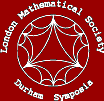 |
| Home |
| Outline |
| Participants |
| Programme |
| Online Talks |
| Abstracts |
 |
| London
Mathematical Society Durham Symposium |
| Combinatorial and Geometric Structures in Representation Theory |
| Monday 6th July - Thursday 16th July 2009 |
| Outline More than 100 years after its birth, representation theory is a vibrant, growing subject, and a way of thinking that has been valuable in many very different areas of mathematics. It is a very broad topic which crosses many fields including Lie algebras, finite and algebraic groups, combinatorics, geometry, integrable systems, analysis, category theory, knot theory, mathematical physics and number theory. The proposed Durham symposium will concentrate on combinatorial, algebraic and geometric aspects of representation theory, and will bring together mathematicians working in representation theory from these directions, with an aim of finding common ground and discussing exciting recent developments. The symposium will bring together leading researchers for a 10 day period of concentration, consolidation and cross-fertilization. The programme will be organised to focus on recent breakthroughs and methods in representation theory, particularly where interactions between different specialities are likely to be beneficial. The topics have been chosen to reflect areas where there has been significant recent progress and where there is much high-level international activity: semisimple Lie algebras, quantum groups and crystal bases; algebraic groups and Lie algebras in positive characteristic; Hecke algebras; quivers; cluster algebras; group representation theory. The headings are broad and there is a great deal of overlap between them. For instance the crystal base theory for Fock space representations of (quantum) affine algebras, a combinatorial area of Lie theory, plays a significant role in all these sections; the LLT conjecture on decomposition matrices of Hecke algebras, which was proved by Ariki, was motivated by this. There are deep connections to symmetric function theory which is another of the threads tying the proposal together; symmetric functions have been at the centre of representation theory since the first study of the representation theory of symmetric groups by Frobenius and Schur. Here Schur polynomials and their generalisations to Macdonald polynomials provide many research directions: finding combinatorial descriptions of representation theoretic data; using representation theory and/or geometry to prove positivity claims, etc. There is great interest in understanding combinatorial descriptions of these polynomials, and of generalising them and the corresponding background theory from symmetric groups to other Weyl groups. This crosses all the topics above and unifies much of representation theory and combinatorics. |
| Organising Committee: Jonathan Brundan (University of Oregon), Joseph Chuang (City University, London), Iain Gordon (University of Edinburgh) and Bernard Leclerc (Université de Caen) |